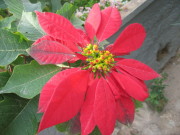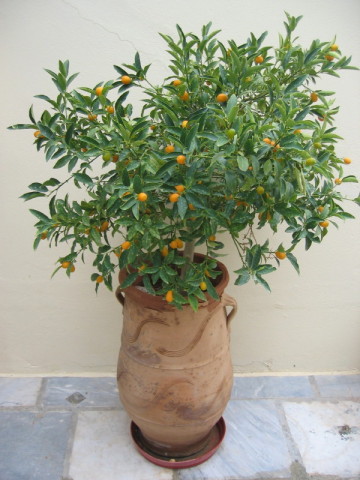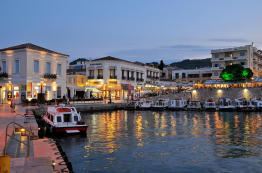Winter Flora
FESTIVE FLORA...reds and oranges for Christmas and the New Year
What could be better than natural Christmas decorations? The red berries of the holly and the white of the mistletoe are synonymous with the festive season, but in Greece there are plenty of seasonal fruits and flowers with their striking reds and oranges to brighten up the balcony, veranda or the garden.
Festive traditions too – smashing a pomegranate on the doorstep to leave the abundant seeds inside to scatter across the floor, as the seeds of good fortune. This may be considered just as much fun as kissing under the mistletoe! The Pomegranate or Punica – a native from Asia – was naturalised in Greece and other parts of the Mediterranean a very long time ago. The fruit grows on rounded, deciduous small trees that can grow between 3 and 5 metres high. Bright green leaves sprout in the spring through to autumn, often giving the tree a spiny, shrub-like appearance. Tubular shaped flowers open in early summer too and remain until early autumn. The winter fruits are as large as oranges, about 7-10 cm in diameter. The skin is leathery in texture and is a deep orange- red, which can quickly turn to brown. The edible part of the fruit, has a red-white flesh, but with many seeds making it quite difficult to eat. The leaves turn golden and the colourful fruits, against this leafy backdrop, make a beautiful winter garden decoration. When picked and brought inside, they can be left until they dry out, and then sprayed gold or silver. Pomegranate also has some very important healing qualities, such as gargling the juice to combat sore throats. In ancient Greece it was prescribed as an aphrodisiac, a stomach sedative and a cure for intestinal parasites. These qualities gave it its name as a symbol of life for the ancient Greeks and female Gods such as Demeter, Hera, Aphrodite and Persephone also revered the fruit.
One of my personal December- January favourites has to be the small evergreen tree – the Kumquat (also known as Kinkon). This slow-growing tree is also a native to Asia, but grows very well in warm climates such as the Mediterranean. Reaching a height of between 3 to 4.5 metres, the evergreen leaves are alternately arranged along the stem and each measure between 2-7 cm. On top, they are darker green and finely toothed and on the underside they are slightly lighter in colour, resembling other citrus trees, such as the lemon and orange. The small oval fruits, appearing from December and lasting until about June, are between 2-5 cm long and have a leathery orange (slightly yellow) skin. The outside is sweet tasting, although the inner flesh can be slightly bitter, sometimes invoking a screwed up face when trying them for the first time! They are excellent in fruit salad or to be eaten as a dessert, jelly, jam, marmalade, syrup or even candied sweet. Used as a sweet sauce for meat dishes, I discovered that they make a tasty and unusual accompaniment too. In some countries, branches are cut and taken inside for Christmas decorations. In summer they keep looking good, as their delicate white flowers also create a pretty effect.
Definitely not edible, but firmly festive, is the Poinsietta (Euphorbia pulcherrima) a member of the Spurge family. Originating from Mexico, but happy in the Mediterranean climate where, growing out of doors or inside in pots, it can receive enough full sunlight and warmth to really flourish. Its vivid scarlet and green leaves have become a popular Christmas symbol – almost as well known as the holly.
FESTIVE FLORA…REDS AND ORANGES FOR CHRISTMAS AND THE NEW YEAR.
COPYRIGHT LUCY PARASKEVA












